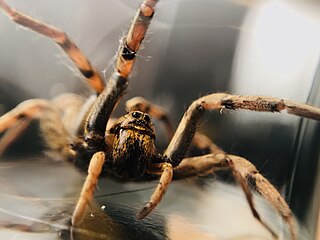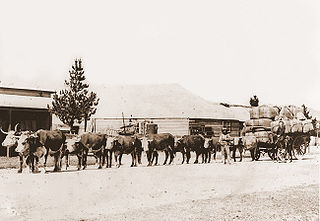Related Research Articles

Anoa, also known as midget buffalo and sapiutan, are a subgenus of Bubalus comprising two species endemic to the island of Sulawesi in Indonesia: the mountain anoa and the lowland anoa. Both live in undisturbed rainforest and are similar in appearance to miniature water buffalo, weighing 150–300 kg (330–660 lb).

Elephants are mammals of the family Elephantidae and the largest existing land animals. Three species are currently recognised: the African bush elephant, the African forest elephant, and the Asian elephant. Elephantidae is the only surviving family of the order Proboscidea; extinct members include the mastodons. The family Elephantidae also contains several now-extinct groups, including the mammoths and straight-tusked elephants. African elephants have larger ears and concave backs, whereas Asian elephants have smaller ears, and convex or level backs. Distinctive features of all elephants include a long trunk, tusks, large ear flaps, massive legs, and tough but sensitive skin. The trunk, also called a proboscis, is used for breathing, bringing food and water to the mouth, and grasping objects. Tusks, which are derived from the incisor teeth, serve both as weapons and as tools for moving objects and digging. The large ear flaps assist in maintaining a constant body temperature as well as in communication. The pillar-like legs carry their great weight.

The fauna of Australia consists of a huge variety of animals; some 83% of mammals, 89% of reptiles, 90% of fish and insects and 93% of amphibians that inhabit the continent are endemic to Australia. This high level of endemism can be attributed to the continent's long geographic isolation, tectonic stability, and the effects of an unusual pattern of climate change on the soil and flora over geological time. A unique feature of Australia's fauna is the relative scarcity of native placental mammals. Consequently, the marsupials – a group of mammals that raise their young in a pouch, including the macropods, possums and dasyuromorphs – occupy many of the ecological niches placental animals occupy elsewhere in the world. Australia is home to two of the five known extant species of monotremes and has numerous venomous species, which include the platypus, spiders, scorpions, octopus, jellyfish, molluscs, stonefish, and stingrays. Uniquely, Australia has more venomous than non-venomous species of snakes.

Gourds include the fruits of some flowering plant species in the family Cucurbitaceae, particularly Cucurbita and Lagenaria. The term refers to a number of species and subspecies, many with hard shells, and some without. One of the earliest domesticated types of plants, subspecies of the bottle gourd, Lagenaria siceraria, have been discovered in archaeological sites dating from as early as 13,000 BC. Gourds have had numerous uses throughout history, including as tools, musical instruments, objects of art, film, and food.

The onager, also known as hemione or Asiatic wild ass, is a species of the family Equidae native to Asia. A member of the subgenus Asinus, the onager was described and given its binomial name by German zoologist Peter Simon Pallas in 1775. Five subspecies have been recognized, one of which is extinct.

Starlings are small to medium-sized passerine birds in the family Sturnidae. The name "Sturnidae" comes from the Latin word for starling, sturnus. Many Asian species, particularly the larger ones, are called mynas, and many African species are known as glossy starlings because of their iridescent plumage. Starlings are native to Europe, Asia and Africa, as well as northern Australia and the islands of the tropical Pacific. Several European and Asian species have been introduced to these areas as well as North America, Hawaii and New Zealand, where they generally compete for habitats with native birds and are considered to be invasive species. The starling species familiar to most people in Europe and North America is the common starling, and throughout much of Asia and the Pacific, the common myna is indeed common.

Hornets are the largest of the eusocial wasps, and are similar in appearance to their close relatives yellowjackets. Some species can reach up to 5.5 cm (2.2 in) in length. They are distinguished from other vespine wasps by the relatively large top margin of the head and by the rounded segment of the abdomen just behind the waist. Worldwide, there are 22 recognized species of Vespa, Most species only occur in the tropics of Asia, though the European hornet, is widely distributed throughout Europe, Russia, North America and Northeast Asia. Wasps native to North America in the genus Dolichovespula are commonly referred to as hornets, but are actually yellowjackets.

Wolf spiders are members of the family Lycosidae, from the Ancient Greek word "λύκος" meaning "wolf". They are robust and agile hunters with excellent eyesight. They live mostly in solitude and hunt alone, and do not spin webs. Some are opportunistic hunters pouncing upon prey as they find it or even chasing it over short distances. Some wait for passing prey in or near the mouth of a burrow.

Huntsman spiders, members of the family Sparassidae, are known by this name because of their speed and mode of hunting. They also are called giant crab spiders because of their size and appearance. Larger species sometimes are referred to as wood spiders, because of their preference for woody places. In southern Africa the genus Palystes are known as rain spiders or lizard-eating spiders. Commonly they are confused with baboon spiders from the Mygalomorphae infraorder, which are not closely related.

The hazel (Corylus) is a genus of deciduous trees and large shrubs native to the temperate Northern Hemisphere. The genus is usually placed in the birch family Betulaceae, though some botanists split the hazels into a separate family Corylaceae. The fruit of the hazel is the hazelnut.

The Pentatomoidea are a superfamily of insects in the Heteroptera suborder of the Hemiptera order. They are commonly referred to as shield bugs, chust bugs, and stink bugs. As Hemiptera, they share a common arrangement of sucking mouthparts.

Wallacea is a biogeographical designation for a group of mainly Indonesian islands separated by deep-water straits from the Asian and Australian continental shelves. Wallacea includes Sulawesi, the largest island in the group, as well as Lombok, Sumbawa, Flores, Sumba, Timor, Halmahera, Buru, Seram, and many smaller islands.

Trimeresurus is a genus of venomous pit vipers found in Asia from the Indian Subcontinent throughout Southeast Asia, China and the Pacific Islands. Currently at least 32 species are recognized. Common names include Asian palm pit vipers, Asian lanceheads and Asian lance-headed vipers.

A working animal or draughtanimal is an animal, usually domesticated, that is kept by humans and trained to perform tasks. They may be pets or draft animals trained to achieve certain tasks, such as guide dogs, assistance dogs, draft horses or logging elephants. Most working animals are either service animals or draft animals. They may also be used for milking or herding. Some, at the end of their working lives, may also be used for meat or other products such as leather.

The Asian leaf turtle is a species of turtle found in Southeast Asia. They are quite common in the pet trade; their carapaces resemble that of a Cuora amboinensis hybrid.

Chimmini Wildlife sanctuary is a protected area located along the Western Ghats in Chalakudy taluk of Thrissur District of Kerala state in India.

A civet is a small, lean, mostly nocturnal mammal native to tropical Asia and Africa, especially the tropical forests. The term civet applies to over a dozen different mammal species. Most of the species diversity is found in southeast Asia. The best-known civet species is the African civet, Civettictis civetta, which historically has been the main species from which a musky scent used in perfumery was obtained. The word civet may also refer to the distinctive musky scent produced by the animals.
The wildlife of Japan includes its flora, fauna and natural habitats. The islands of Japan stretch a long distance from north to south and cover a wide range of climatic zones. This results in a high diversity of wildlife despite Japan's isolation from the mainland of Asia. In the north of the country, north of Blakiston's Line, there are many subarctic species which have colonized Japan from the north. In the south there are south-east Asian species, typical of tropical regions. Between these areas lies the temperate zone which shares many species with China and Korea. Japan also has many endemic species that are found nowhere else in the world.

The Asian badger, also known as the sand badger is a species of badger native to Mongolia, China, Kazakhstan, Kyrgyzstan, the Korean Peninsula and Russia.

Bats are a food source for humans in some areas. Bats are consumed in various amounts in some regions within some European, African, Asian, and Pacific Rim countries and cultures, including Vietnam, Seychelles, Indonesia, Palau, Thailand, China, and Guam. In Guam, Mariana fruit bats are considered a delicacy.
References
- 1 2 "Description and distribution". Archived from the original on 2011-11-14. Retrieved 2012-02-23.